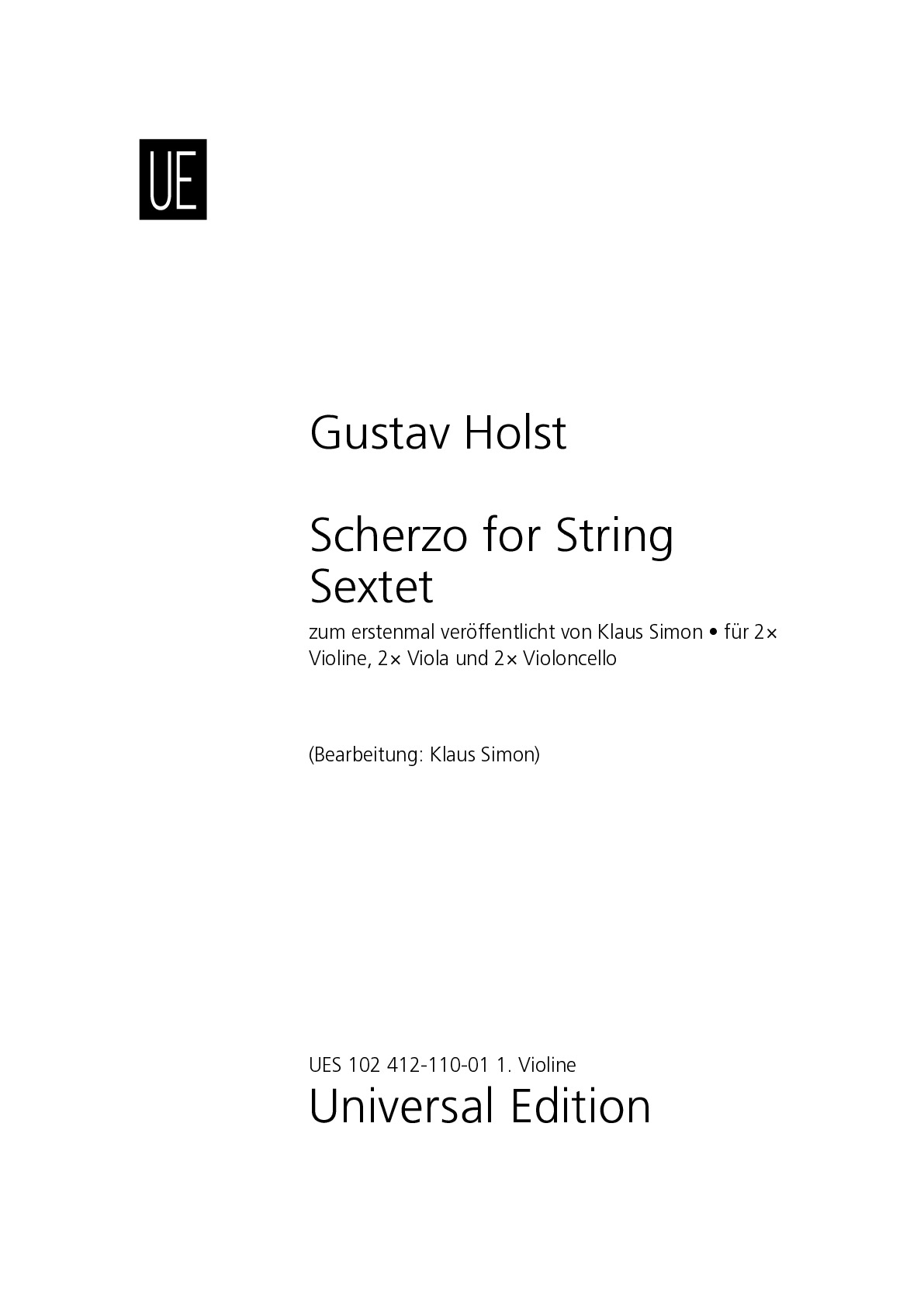.png)
Digital edition
immediately available as PDF
€7.95
Payments:
Shipping:
Gustav Holst
1. Violine (Scherzo for String Sextet)
Bearbeitet von: Klaus Simon
UES102412-110-01
Type: Stimme
Format: 210 x 297 mm
Pages: 8
Digital edition
immediately available as PDF
€7.95
Payments:
Shipping:
Audio preview
Description
Gustav Holst: Scherzo for String Sextet d-minor H. 23 (1897)
Gustav Holst is not considered a notable chamber music composer. His catalog of works contains only a few instrumental works for small ensembles, mostly early works which he himself later described as "early horrors". Although not a “horror,” his Scherzo for string sextet in D minor H. 231 falls into this category of early chamber pieces. Composed in 1897, it has not been published until today, and its official premiere performance took place only on 20th July 2019 in Freiburg, Germany, by a string sextet of players from the Holst-Sinfonietta. This Scherzo is a thoroughly felicitous work, unique in several respects, revealing the young Holst as a musically imaginative composer who had already brilliantly mastered his craft. In the manuscript, "II Scherzo" is written at the top of the first page of the score, suggesting that Holst may have been thinking of a multi-movement sextet at the time of composition. However, no further movements have survived.
Formally, it is a scherzo of truly symphonic proportions (523 measures!) with two trios: a somewhat more leisurely one in B-flat major and a fast one in D major. The actual scherzo is laid out according to classical developmental dramaturgy: the first part establishes two contrasting main ideas, one more rhythmic and gestural in nature, the other more lyrical. The second part develops motives and themes of the two main ideas, before a varied recapitulation presents both main ideas once again in conclusion. What is unusual is how Holst shapes the overall form: on the one hand, he composes flowing transitions between the form sections, including gradual tempo changes; on the other hand, he does not simply repeat the scherzo between and after the two trios, but incorporates newly composed material with abbreviated, further developed recapitulations of the main ideas. The Scherzo closes with a coda that reworks elements of the trios. Thus this early work displays a through-composed formal design which ventures far afield from its traditional scherzo roots, and which, perhaps surprisingly, finds its equal only in Mahler.
Holst's musical ideas already anticipate his more mature style. For example, he often uses a basic knocking rhythm that recalls the ostinati of the Choral Hymns from the Rig Veda op. 26, or the famous hammering rhythm in Mars from The Planets op. 32. A pervading harmonic ambiguity is especially pronounced in the second Scherzo, which leaves the listener uncertain about the home key for a long time from the beginning on, and establishes D major only at the seeming-last moment of the phrase - a foreshadowing of Holst's ambivalent handling of tonalities in later works. And truly masterful is his play with musical motives, which are distributed contrapuntally throughout the ensemble, producing a web of micro-canons and imitations of which even a Beethoven would have been proud.
Given all these qualities of the piece, it remains a mystery why neither Holst nor his executors ever, to this day, brought this piece to the public. It may not yet be a work by the mature, accomplished composer, but as a brilliant early offering on the compositional altar, it certainly deserves the listener’s attention and appreciation. May this edition finally rouse Holst’s sleeping beauty from its slumber.
1 H. stands for a entry in A Thematic Catalogue of Gustav Holst’s Music by Holst's daughter Imogen Holst, London 1974.
Denzlingen, April 2022
Cornelius Bauer and Klaus Simon
About the Edition
This edition is based on Holst's manuscript, which is archived in the British Library in London and listed under the number Add MS 57868. Most of Holst's handwriting is clearly legible and could be transferred into print without major problems. Minor errors or inconsistencies have been corrected from the context of the work. Missing slurs, etc., have been added in parentheses.
I thank Chris Cope of the Holst-Society and Colin Matthews of the Holst-Foundation for providing the scan of Holst's manuscript and permission to finally make this work available to the public.
Furthermore, I thank my long-time friend, the violinist and musicologist Dr. Cornelius Bauer, for the preface. Dr. Bauer wrote it, initially, for the official world premiere in 2019, and he worked with me recently to supplement it with some further aspects of content for this edition.
Denzlingen, April 2022
Klaus Simon
Performers of the world premiere on 20th July 2019 in the Pauluskirche in Freiburg/Germany
String sextet of the Holst-Sinfonietta:
Sylvia Oelkrug – 1st violin; Cornelius Bauer – 2nd violin
Filomena Felley – 1st viola; Annette Blecher – 2nd viola
Philipp Schiemenz – 1st violoncello; Mika Tamura – 2nd violoncello
(translations by Marika Fischer Hoyt)
More information
Type: Stimme
Format: 210 x 297 mm
Pages: 8

